engine overheat OLDSMOBILE SILHOUETTE 2003 Owners Manual
[x] Cancel search | Manufacturer: OLDSMOBILE, Model Year: 2003, Model line: SILHOUETTE, Model: OLDSMOBILE SILHOUETTE 2003Pages: 466, PDF Size: 21.55 MB
Page 120 of 466
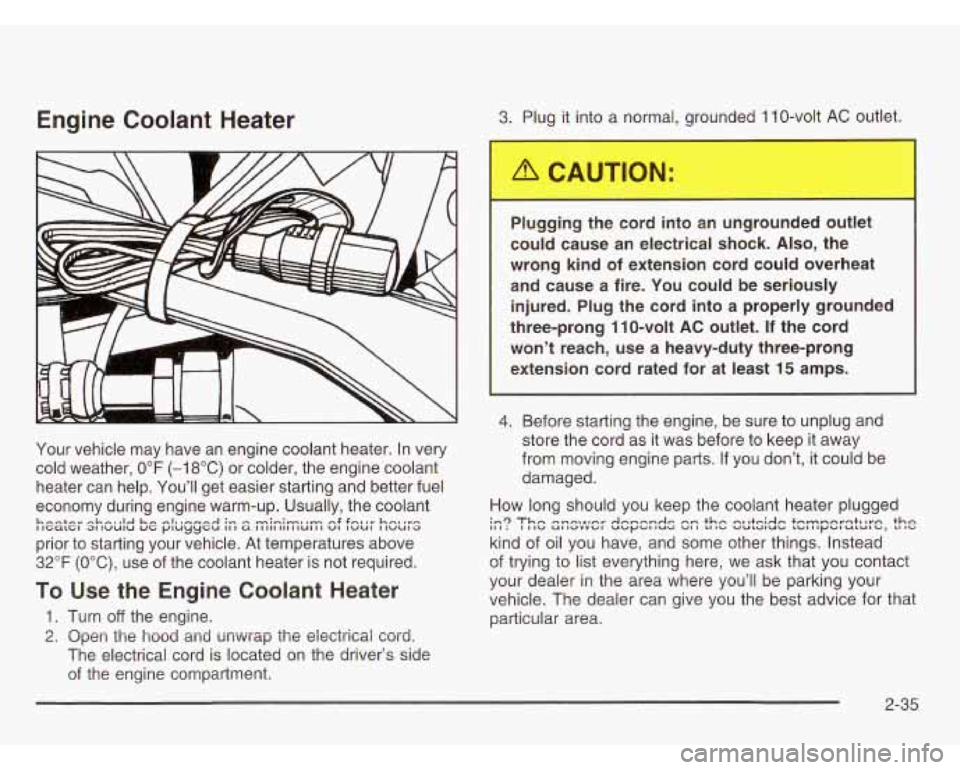
Engine Coolant Heater
Your vehicle may have an engine coolant heater. In very
cold weather,
0°F (-1 8°C) or colder, the engine coolant
heater can help. You’ll get easier starting and better fuel
economy during engine warm-up. Usually, the coolant
prior to starting your vehicle. At temperatures above
32°F (OOC), use of the coolant heater is not required.
h--+-r -hhm .I& h- -1, me.n-~I ;c. - -rc.n-~ I- n.F 4-v vv hew 8“- .. lltialtt ~IIVUIU uti pluyycu III a IIIIIIIIIIUII~ wl lwut IIUUID
To Use the Engine Coolant Heater
1. Turn off the engine.
2. Open the hood and unwrap the eieciricai cord.
The electrical cord is located on the driver’s side
of the engine compartment.
3. Plug it into a normal, grounded 1 10-volt AC outlet.
Plugging the cord into an ungrounded outlet
could cause an electrical shock.
Also, the
wrong kind
of extension cord could overheat
and cause a fire. You could be seriously
injured. Plug the cord into a properly grounded
three-prong 110-volt
AC outlet. If the cord
won’t reach, use a heavy-duty three-prong
extension cord rated
for at least 15 amps.
4. Before starting the engine, be sure to unplug and
store the cord as it was before to keep it away
from moving engine parts.
If you don’t, it could be
damaged.
How long should you keep the coolant heater plugged
kind of oil you have, and some other things. Instead
of trying to list everything here, we ask that you contact
your dealer in the area where you’ll be parking your
vehicle. The dealer can give you the best advice for that
particular area.
in3 Thn mncxL,nr AnnnnAc nn thn nl ItciAn tnmnnvqtl lvn thn I, 1 ; 1 I Ib UI 1dVVbI UbfJbI IUU VI I LI ,b VUl~lUb ,bI I IybluLUI u, LI I”
2-35
Page 123 of 466
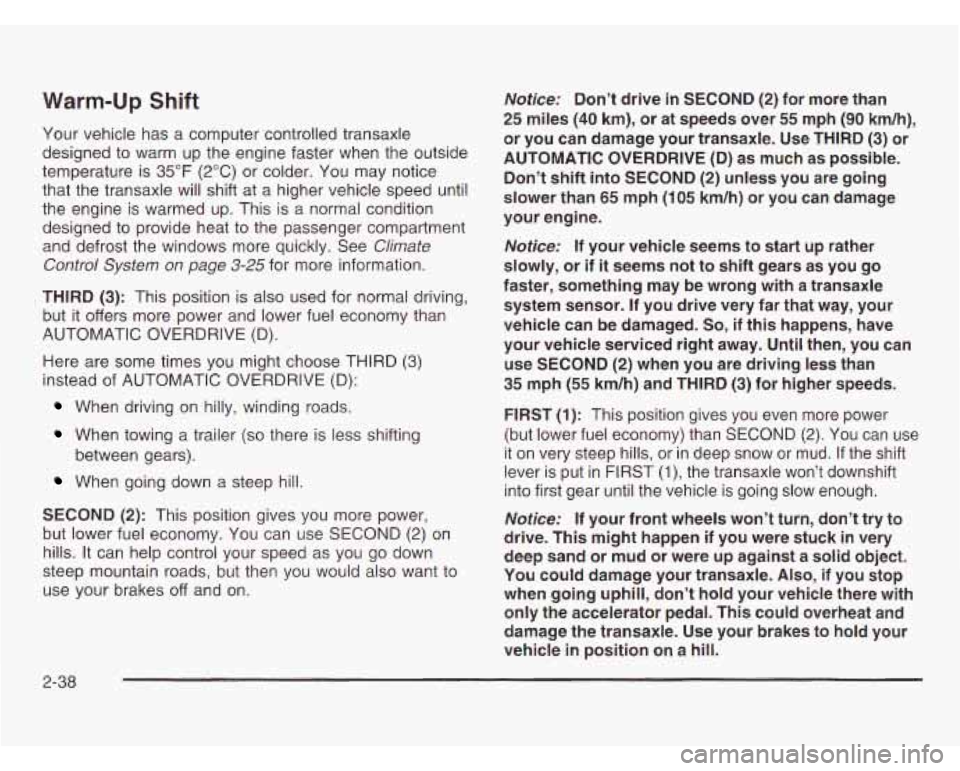
Warm-up Shift
Your vehicle has a computer controlled transaxle
designed to warm up the engine faster when the outside
temperature is
35°F (2°C) or colder. You may notice
that the transaxle will shift at a higher vehicle speed until
the engine is warmed up. This is a normal condition
designed to provide heat to the passenger compartment
and defrost the windows more quickly. See
Climate
Control System on
page 3-25 for more information.
THIRD
(3): This position is also used for normal driving,
but it offers more power and lower fuel economy than
AUTOMATIC OVERDRIVE (D).
Here are some times you might choose THIRD
(3)
instead of AUTOMATIC OVERDRIVE (D):
When driving on hilly, winding roads.
When towing a trailer (so there is less shifting
When going down a steep hill. between gears).
SECOND
(2): This position gives you more power,
but lower fuel economy. You can use SECOND
(2) on
hills. It can help control your speed as you go down
steep mountain roads, but then you would also want to
use your brakes
off and on.
Notice: Don’t drive in SECOND (2) for more than
25 miles (40 km), or at speeds over 55 mph (90 km/h),
or you can damage your transaxle. Use THIRD
(3) or
AUTOMATIC OVERDRIVE (D) as much as possible.
Don’t
shift into SECOND (2) unless you are going
slower than
65 mph (105 km/h) or you can damage
your engine.
Notice: If your vehicle seems to start up rather
slowly, or if
it seems not to shift gears as you go
faster, something may be wrong with a transaxle
system sensor. If you drive very far that way, your
vehicle can be damaged.
So, if this happens, have
your vehicle serviced
right away. Until then, you can
use SECOND
(2) when you are driving less than
35 mph (55 km/h) and THIRD (3) for higher speeds.
FIRST
(1): This position gives you even more power
(but lower fuel economy) than
SECOND (2). You can use
it on very steep hills, or in deep snow or mud.
If the shift
lever is put in FIRST
(I), the transaxle won’t downshift
into first gear until the vehicle is going slow enough.
Notice: If your front wheels won’t turn, don’t try to
drive. This might happen if you were stuck in very
deep sand or mud or were up against a solid object.
You could damage your transaxle. Also, if you stop
when going
uphill, don’t hold your vehicle there with
only the accelerator pedal. This could overheat and
damage the transaxle. Use your brakes to hold your
vehicle in position on a
hill.
2-38
Page 126 of 466
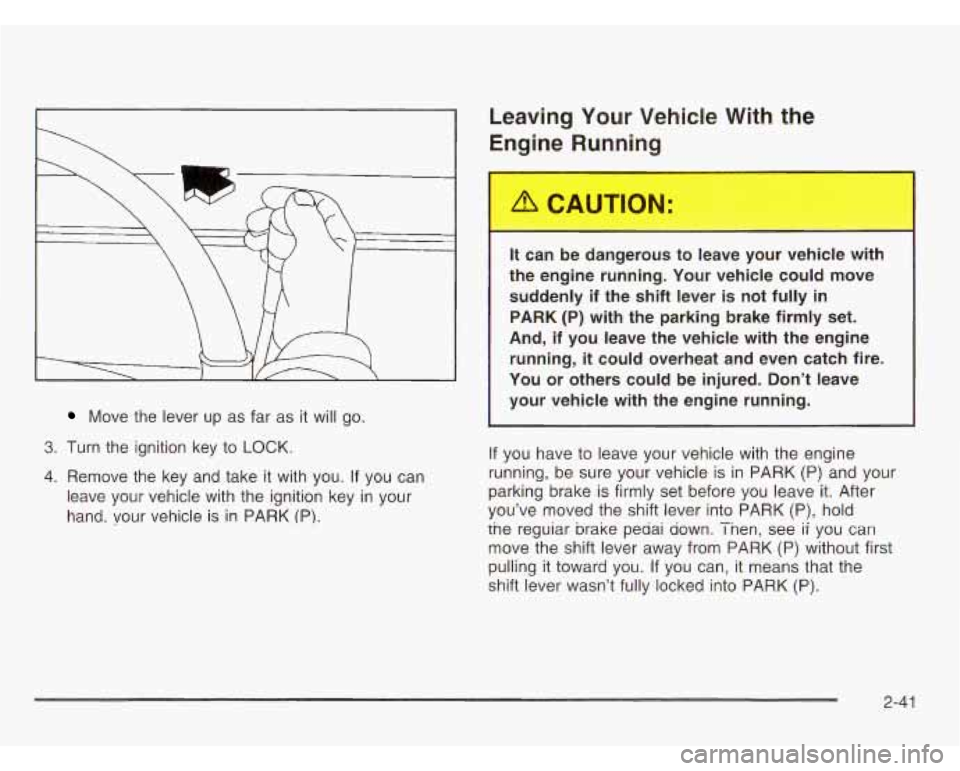
Move the lever up as far as it will go.
3. Turn the ignition key to LOCK.
4. Remove the key and take it with you. If you can
leave your vehicle with the ignition key in your
hand. your vehicle is in PARK (PI.
Leaving Your Vehicle With the
Engine Running
It can be dangerous to leave \w.iicle with
the engine running. Your vehicle could move suddenly if the shift lever
is not fully in
PARK (P) with the parking brake firmly set.
And, if you leave the vehicle with the engine
running,
it could overheat and even catch fire.
You or others could be injured. Don’t leave
I your vehicle with the engine running.
I
If you have to leave your vehicle with the engine
running, be sure your vehicle is in PARK
(P) and your
parking brake is firmly set before you leave it. After
you’ve moved the shift lever into PARK (P), hold
the reguiar brake pedai down. Then, see
ii you can
move the shift lever away from PARK
(P) without first
pulling it toward you. If you can,
it means that the
shift lever wasn’t fully locked into PARK (P).
2-41
Page 203 of 466
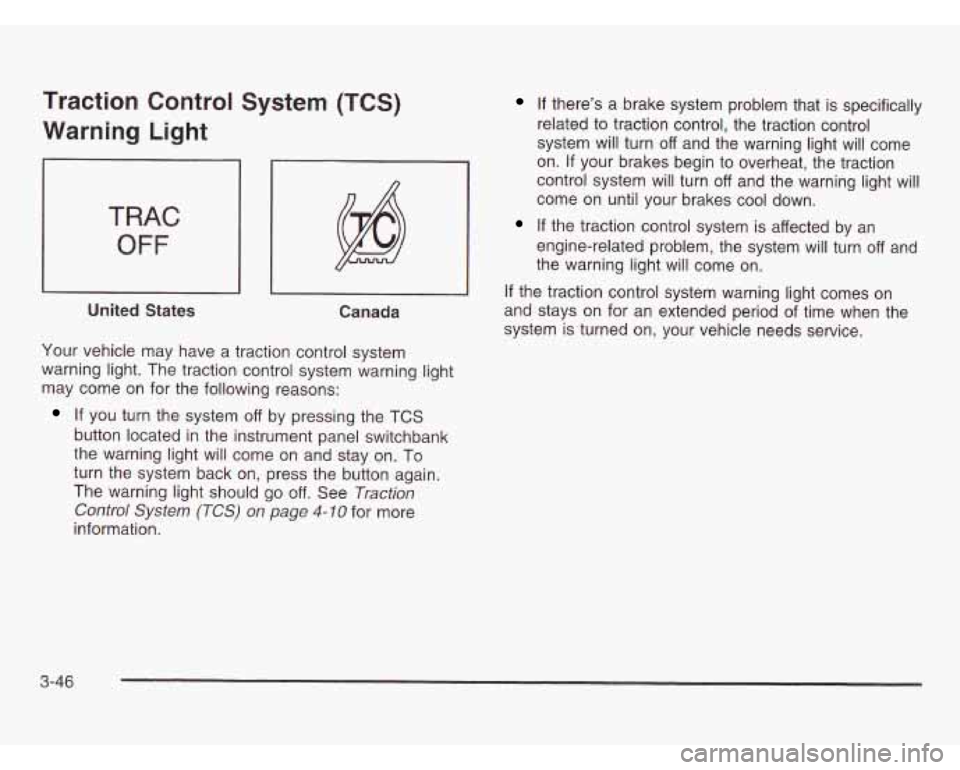
Traction Control System (TCS)
Warning Light
TRAC
OFF
United States Canada
Your vehicle may have a traction control system
warning light. The traction control system warning light
may come on for the following reasons:
If you turn the system off by pressing the TCS
button located in the instrument panel switchbank
the warning light will come on and stay on.
To
turn the system back on, press the button again.
The warning light should go
off. See Traction
Control System
(TCS) on page 4-10 for more
information.
If there’s a brake system problem that is specifically
related to traction control, the traction control
system will turn off and the warning light will come
on.
If your brakes begin to overheat, the traction
control system will turn
off and the warning light will
come on until your brakes cool down.
If the traction control system is affected by an
engine-related problem, the system will turn
off and
the warning light will come on.
If the traction control system warning light comes on
and stays on for an extended period of time when the
system is turned on, your vehicle needs service.
3-46
Page 204 of 466
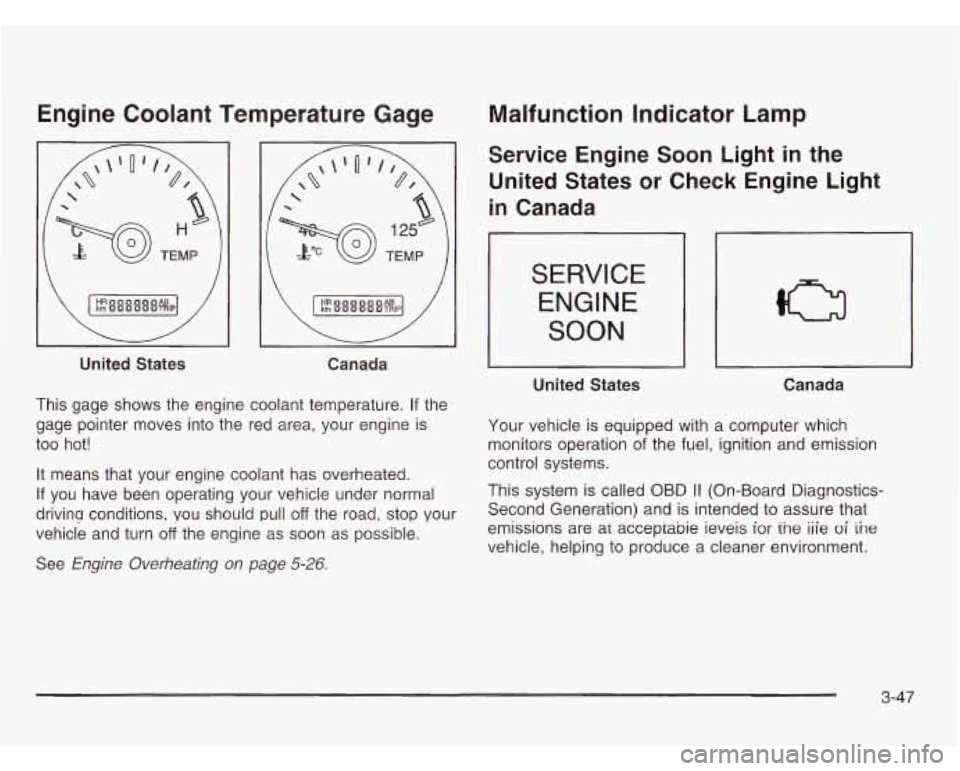
Engine Coolant Temperature Gage
United States
\[-I/
u
Canada
This gage shows the engine coolant temperature.
If the
gage pointer moves into the red area, your engine is
too hot!
It means that your engine coolant has overheated.
If you have been operating your vehicle under normal
drivinq conditions, vou should pull
off the road, stop your
vehicle and turn
off the engine as soon as possible.
See
Engine Overheating on page 5-26.
Malfunction Indicator Lamp
Service Engine Soon Light in the
United States or Check Engine Light
in Canada
SERVICE
ENGINE
SOON
United States Canada
Your vehicle is equipped with a computer which
monitors operation
of the fuel, ignition and emission
control systems.
This system is called
OBD II (On-Board Diagnostics-
Second Generation) and is intended
to assure that
emissions are at accepiabie ieveis ior ine iiie
of ihe
vehicle, helping to produce a cleaner environment.
3-47
Page 209 of 466
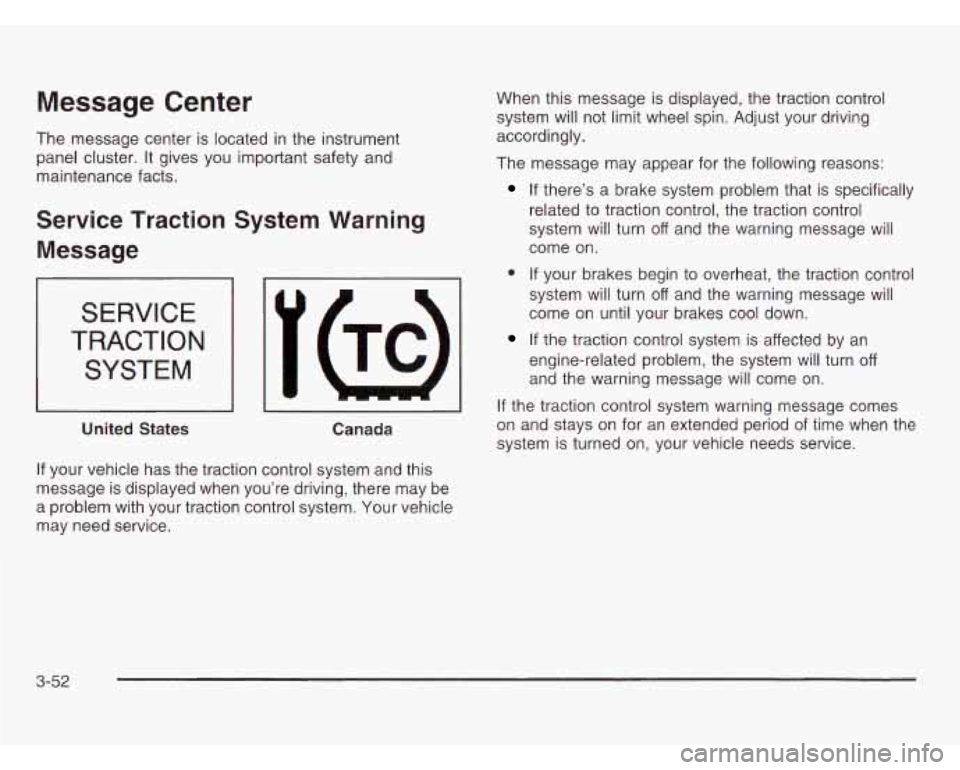
Message Center
The message center is located in the instrument
panel cluster.
It gives you important safety and
maintenance facts.
Service Traction System Warning
Message
SERVICE
TRACTION
SYSTEM
United States
I I
Canada When
this message is displayed, the traction control
system will not limit wheel spin. Adjust your driving
accordingly.
The message may appear for the following reasons:
If there’s a brake system problem that is specifically
related to traction control, the traction control
system will turn
off and the warning message will
come on.
e If your brakes begin to overheat, the traction control
system will turn
off and the warning message will
come on until your brakes cool down.
engine-related problem, the system will turn off
and the warning message will come on.
If the traction control system warning message comes
on and stays on for an extended period of time when the
system is turned on, your vehicle needs service.
If the traction control system is affected by an
If your vehicle has the traction control system and this
message is displayed when you’re driving, there may be
a problem with your traction control system. Your vehicle
may need service.
3-52
Page 210 of 466

Traction Active Message
TRACTION ACTIVE
United States Canada
If your vehicle has the traction control system, the
TRACTION ACTIVE message will appear when the
traction control system is limiting wheel spin. You may
feel or hear the system working, but this is normal.
Slippery road conditions may exist
if this message
appears,
so adjust your driving accordingly.
The message will stay on for a few seconds after
the traction control system stops limiting wheel spin.
Engine Coolant Temperature
Warning Message
I 1 I
HOT
COOLANT
TEMP
United States Canada
This message will come on when your engine gets
too hot.
If this message comes on, it means that your engine
coolant has overheated. If you have been operating your
vehicle under normal driving conditions, you should
pull
off the road, stop your vehicle and turn off the
engine as soon as possible.
See
En-qine Overheatinq on page 5-26.
3-53
Page 274 of 466

To turn the system off,
press the TCS button
located on the instrument
panel switchbank.
All-Wheel Drive (AWD) System
If your vehicle has all-wheel drive (AWD), the AWD
system operates automatically without any action
required by the driver.
If the front drive wheels begin
to slip, the rear wheels will automatically begin to
drive the vehicle as required. There may be a slight
engagement noise during hard use but this is normal.
During heavy
AWD applications, the engine torque
may be reduced to protect AWD system components.
If the vehicle is exposed to extended heavy AWD usage,
the AWD system will shut itself
off to protect the system
from overheatinq. When the system
cools down, the
AWD system will activate itself again automatically; this
If the System is hliting wheel Spin when
YOU press the cool-down can take up to 20 minutes depending on
button, the traction active message will go
off, but outside temperature and vehicle use. See All-Wheel
the system will not turn off until there is no longer a Drive Disable Warning Message on page 3-59.
current need to limit wheel spin. The TRAC OFF light will
come on to remind you the system is
off. You can
turn the system back
on at any time by pressing the
button again.
The traction control system warning
4-1 1
Page 293 of 466
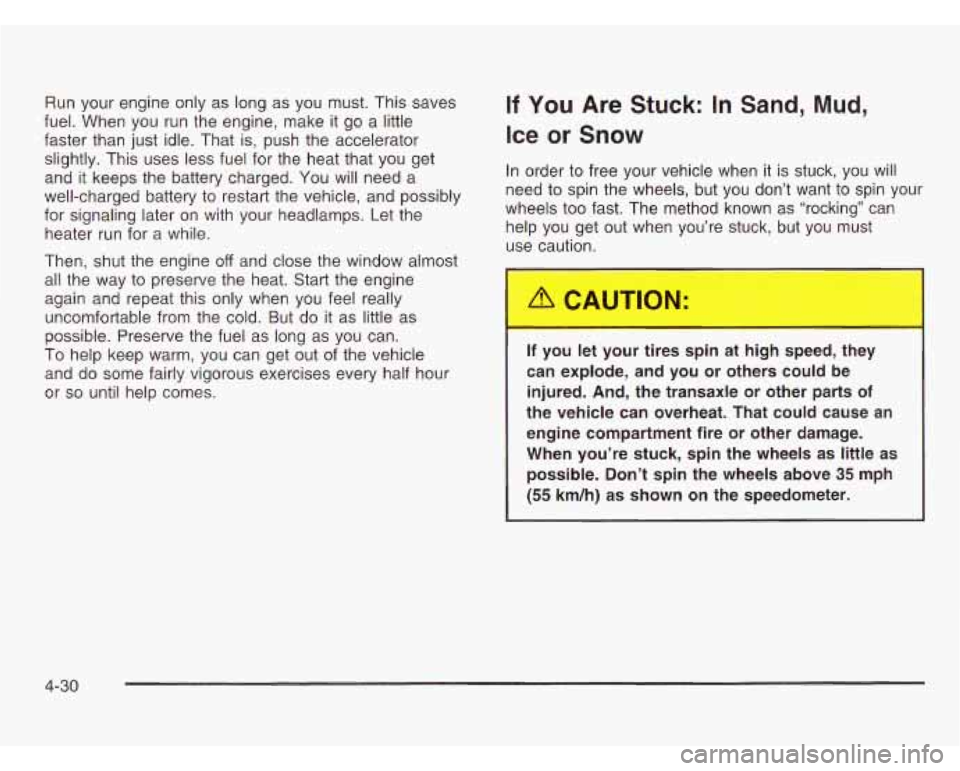
Run your engine only as long as you must. This saves
fuel. When you run the engine, make it
go a little
faster than just idle. That is, push the accelerator
slightly. This uses less fuel for the heat that you get
and
it keeps the battery charged. You will need a
well-charged battery to restart the vehicle, and possibly
for signaling later on with your headlamps. Let the
heater run for a while.
Then, shut the engine
off and close the window almost
all the way to preserve the heat. Start the engine
again and repeat this only when you feel really
uncomfortable from the cold. But do it as little as
possible. Preserve the fuel as long as you can.
To help keep warm, you can get out of the vehicle
and do some fairly vigorous exercises every half hour
or
so until help comes.
If You Are Stuck: In Sand, Mud,
Ice or Snow
In order to free your vehicle when it is stuck, you will
need to spin the wheels, but you don’t want to spin your
wheels too fast. The method known as “rocking” can
help you get out when you’re stuck, but you must
use caution.
If you let your tires spin at high spe ~ ~, ~ rey
can explode, and you or others could be
injured. And, the transaxle or other parts
of
the vehicle can overheat. That could cause an
engine compartment fire or other damage.
When you’re stuck, spin the wheels as little as
possible. Don’t spin the wheels above
35 mph
(55 km/h) as shown on the speedometer.
4-30
Page 308 of 466
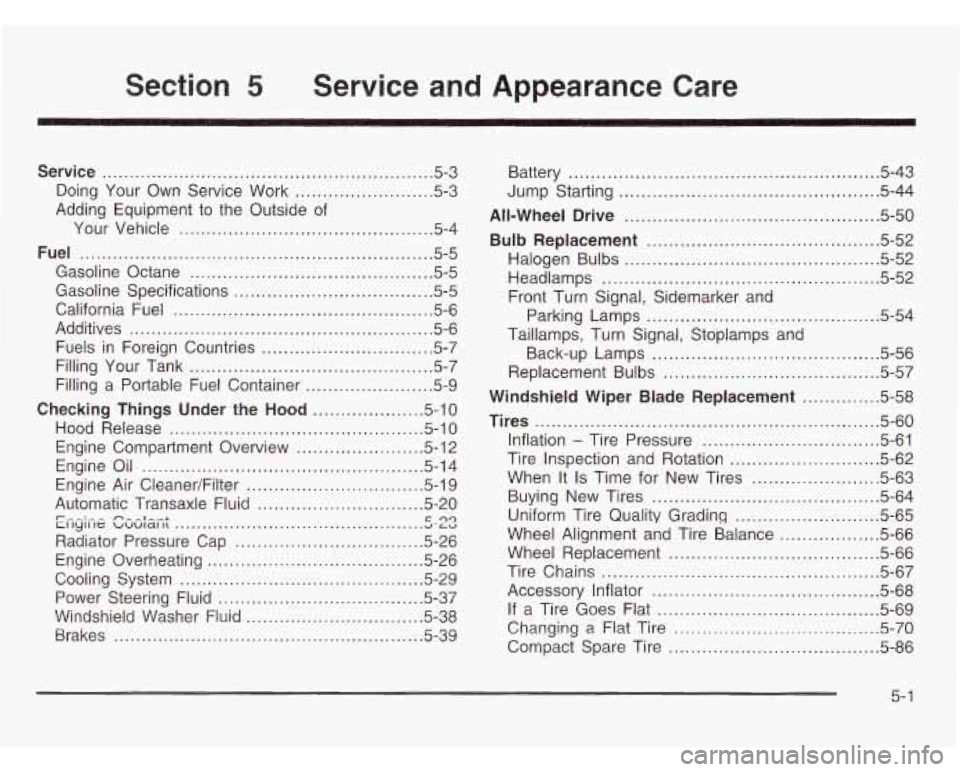
Section 5 Service and Appearance Care
Service ............................................................ 5.3
Doing Your Own Service Work
......................... 5.3
Adding Equipment to the Outside
of
Your Vehicle .............................................. 5-4
Fuel
.............................................................. -5-5
Gasoline Octane
............................................ 5-5
Gasoline Specifications
................................... 5-5
California Fuel
............................................... 5-6
Additives
....................... .... ......... 5-6
Fuels in Foreign Countries
........... ..... 5-7
Filling Your Tank
............................ ..... 5-7
Filling a Portable Fuel Container
.................... 5-9
Checking Things Under the
Hood .................. -5-1 0
Hood Release .............................................. 5-10
Engine Compartment Overview ....................... 5-12
Engine Oil
................................................... 5-14
Engine Air CleanedFilter
................................ 5-19
Automatic Transaxle Fluid
.............................. 5-20
Radiator Pressure Cap
............................... 5-26
Engine Overheating
.................................... 5-26
Cooling System
............................. , ....... 5-29
Power Steering Fluid .................. , ....... 5-37
Windshield Washer Fluid
................. , ....... 5-38
Brakes
.......................... .... ........ 5-39
r.--.:.-- ---I-.- b CI lyll IC uuvlal I1 4-LU c r)r) .............................................
Battery ........................................................ 5.43
Jump Starting
............................................... 5-44
All-Wheel Drive
.............................................. 5-50
Bulb Replacement .......................................... 5-52
Halogen Bulbs
.............................. ......... 5-52
Front Turn Signal, Sidemarker and
Taillamps, Turn Signal, Stoplamps and
Headlamps
...................................... ..... 5-52
Parking Lamps
.............................. ..... 5-54
Replacement Bulbs
....................................... 5-57
Back-up Lamps
......................................... 5-56
Windshield Wiper Blade Replacement
.............. 5-58
Tires
.............................................................. 5-60
Inflation
- Tire Pressure ................................ 5-61
Tire Inspection and Rotation
........................... 5-62
When It
Is Time for New Tires ....................... 5-63
Buying New Tires
......................................... 5-64
Uniform Tire Quality Grading
.......................... 5-65
Wheel Alignment and Tire Balance
.................. 5-66
Wheel Replacement
...................................... 5-66
Tire Chains
.................................................. 5-67
Accessory Inflator
......................................... 5-68
If a Tire Goes Flat ........................................ 5-69
Changing a Flat Tire ..................................... 5-70
Compact Spare Tire ...................................... 5-86
5- 1